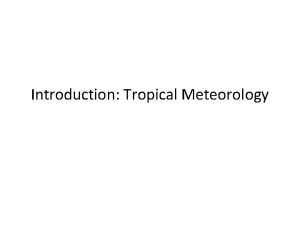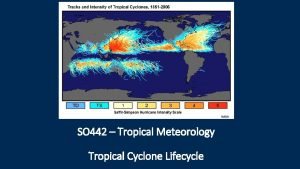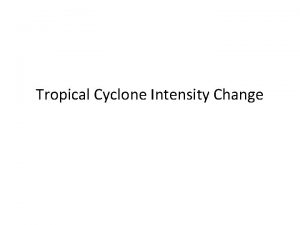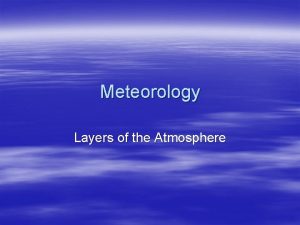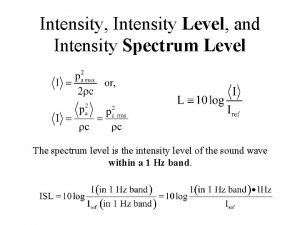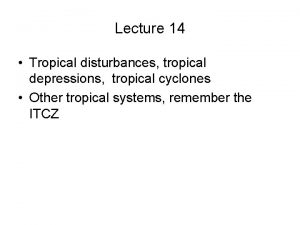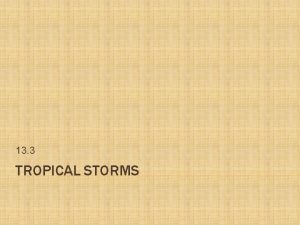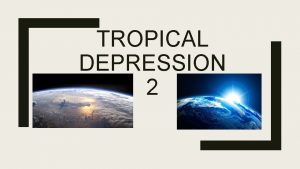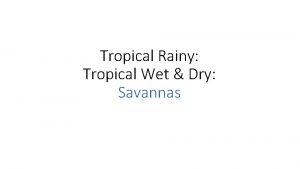TC Potential Intensity SO 442 Tropical Meteorology CISK


















- Slides: 18

TC Potential Intensity SO 442 – Tropical Meteorology

CISK The Conditional Instability of the Second Kind (CISK) theory of TC potential intensity is one that we have already been looking at conceptually L L heat flux PGF velocity Coriolis Centrif. Friction

CISK The Conditional Instability of the Second Kind (CISK) theory of TC potential intensity is one that we have already been looking at conceptually Its essential tenets are as follows: 6. Latent heat release is converted to mechanical energy (wind) via the release of buoyant instability (CAPE is required) 7. Increasingly buoyant air accelerates upward drawing air in ever faster from below To intensify, latent heat release must provide energy in excess of that lost to friction in the boundary layer (i. e. , the winds will accelerate) Faster winds greater convergence higher theta-e greater latent heat release faster winds etc. The system positively feeds back on itself wind Atmosphere needs to be conditionally unstable Latent heating L heat flux wind

WISHE The Wind Induced Surface Heat Exchange (WISHE) theory of TC potential intensity idealizes the TC as a closed system (heat engine) Before applying this idealization to a TC, we’ll define what we mean by “heat engine”

WISHE A heat engine process involves the uptake of heat into a system at a certain temperature and the release of heat at some colder temperature The heat thus “flows” through the system from warm to cold and less heat leaves the system than is taken in…the difference goes to performing mechanical work 3 2 4 1

WISHE 3 2 We can now evaluate the work done and heat supplied by the environment on each leg, beginning each time with the explicit form of the 1 st Law… Leg 1 4 1

WISHE Leg 1 3 2 Leg 3 4 1 Leg 4 and the total work done for the closed cycle is: The efficiency of the cycle is: Equivalent to the work done on leg 1 (if the process is isothermal an input of heat is required to offset the expansional cooling

WISHE The efficiency of the cycle is: 3 2 4 1 A key characteristic of the heat engine is evidenced here: • Heat must be supplied to the system at the warmer temperature What is the TC analog • Heat must be extracted from the system at the cooler temperature to all of this? Why must these be true physically? • If it weren’t, the system would cool by adiabatic expansion • If it weren’t, the system would warm by adiabatic compression This requires that there be a high-temperature external reservoir supplying heat during the warm phase and a low temperature “sink” drawing off heat during the cold phase The heat engine extracts mechanical energy from the tendency of heat to flow from a warm reservoir to a cold one

A hurricane’s efficiency: How to increase efficiency? • Warmer SSTs • Colder cloud tops Results in greater work done (i. e. , greater kinetic energy…faster winds) 3 2 4 1

In differential form: For the mature hurricane, the parcel flowing in toward the eye has no change in enthalpy (since the process is isothermal)…therefore: The larger the amount of expansion work done, the larger the fall in pressure during leg 1 Consistent with the reason that air begins 2 flowing into the initial disturbance in the first place (low pressure) It is the falling pressure that causes leg 1 to be isothermal expansion 4 Very low pressure 1 3

WISHE = Wind Induced Surface Heat Exchange Lastly, how do we get from “energy” (work/heat) in a TC to winds? 1) 2) 3) If the TC is “steady state”, work done (winds) perfectly offsets dissipative heating 4) 5) Now putting 2) into 3) gives, Now putting 4) into 5) gives, 6)

WISHE = Wind Induced Surface Heat Exchange Lastly, how do we get from “energy” (work/heat) in a TC to winds? 6) 7) “new” efficiency What happened to efficiency? vs. Due to heat added by frictional dissipation at the ocean surface Why? increased

WISHE = Wind Induced Surface Heat Exchange Lastly, how do we get from “energy” (work/heat) in a TC to winds? 7) and the intensive (per unit mass) work is manifest in the kinetic energy of the TC winds 8) If we assume that all of the kinetic energy is in the eyewall… Provides a rough sense of how wind speed depends on the temperature difference between the TC inflow and outflow

WISHE = Wind Induced Surface Heat Exchange requires faster wind to achieve more heat flux from the ocean and frictional heating 3 2 4 1

Utility of PI • Provides an inferred max possible intensity for an observed TC anywhere on the globe • Provides an upper-bound to model forecasts of actual storm intensity • Provides insight into how quickly the environment can recover after TC passage A measure of PI Typhoon Tip (1979): 870 h. Pa Hurricane Wilma (2005): 882 h. Pa

Summaries of PI increasing convergence increasing latent heating increasing convergence TC intensifies in a positive feedback (assuming the presence of CAPE) Problems with CISK • Available CAPE (generally meager to begin with) gets used up quickly • Doesn’t readily distinguish air-sea interface from air-land interface… WISHE (Emanuel, 1980 s) • Does not require CAPE (atmosphere can be convectively neutral) • Need sufficient surface-based wind over ocean water to activate fluxes of sensible and latent heat faster winds greater flux greater latent heating greater pressure drop faster winds etc.

WISHE = Wind Induced Surface Heat Exchange faster winds greater flux greater latent heating greater pressure drop faster winds etc. 3 2 Latent 900 h. Pa heating 4 PGF 1

Summaries of PI Important factor is convergence Important factor is heat flux In both cases, need an incipient vortex In CISK, an initially small vortex is sufficient to initiate convergence In WISHE, need a finite amplitude vortex to activate sufficient flux (in the Atlantic, one source of these are African Easterly Waves: AEWs)
 Cisk meteorology
Cisk meteorology Introduction to tropical meteorology
Introduction to tropical meteorology Introduction to tropical meteorology
Introduction to tropical meteorology Unit of potential
Unit of potential How to find pressure potential
How to find pressure potential Flaccid turgid and plasmolysis
Flaccid turgid and plasmolysis V = pe/q
V = pe/q Action potential resting potential
Action potential resting potential Action potential
Action potential Electric potential
Electric potential Sources of biopotential
Sources of biopotential What is water potential
What is water potential Potential and potential difference
Potential and potential difference Market potential and forecasting
Market potential and forecasting Graded potential vs action potential
Graded potential vs action potential Potential and potential difference
Potential and potential difference Transmission across a synapse
Transmission across a synapse Graded potential vs action potential
Graded potential vs action potential Equipotential lines
Equipotential lines

